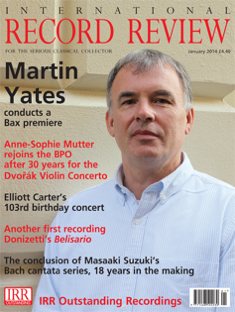Texte paru dans: / Appeared in:
*

International Record Review - (01//2014)
Pour
s'abonner / Subscription information
Channel
CCSSA35513
0723385355137 (ID350)
This extraordinarily beautiful recording is one of the finest solo Baroque violin compilations I’ve heard to date. Not only is the playing of Rachel Podger exemplary and authoritative but the Channel Classics SACD production is at once sublimely atmospheric and miraculously accurate in its reproduction of every nuance and inflection. Seldom has the physical interaction between gut strings, horsehair and a vibrating, living instrument in the hands of a masterful performer been captured with such penetrating immediacy, with this superlative disc affording a host of delights at every turn.
Podger’s playing suggests that recording this album was a pleasurable labour of love for her, such is the fastidious attention to detall and sincerity of utterance with which she infuses music which, in some cases, will probably be obscure to most.
Bach’s Partita for solo flute, BWV 1013 has long been a traditional addendum to the Partitas and Sonatas for solo violin and, indeed, the manuscript was found at the end of an early complete copy of this set. In all probability, the copyist knew no more of its provenance than we really do today; for instance, was this piece written originally for flute or violin, and if the former, did it ever have a basso accompaniment? Moreover, there are practical problems, too, which seem to imply that the work may have been conceived originally for solo violin: where, for example, asks Timothy Jones in his booklet note, might a flautist have breathed during the Allemande? Still, as Podger demonstrates, the Partita is eminently well suited to the violin and this account, in her own arrangement, is outstanding in every way.
Little is know of the Neapolitan violinist composer Nicola Matteis (he died at some point after 1713 , but his birth year cannot be determined) other than that he was active in London from around 1670, where he attracted considerable acclaim . The diary entry of John Evelyn for November 19th, 1674 records that ‘I heard the stupendious [sic] violin(ist) Signor Nichola . . . whom certainly mortal man never exceeded on that instrument . . . ‘ . His published compositions included four volumes of Ayres (1676-85) aimed principally at musical amateurs, from which three contrasting pieces are included here.
Best know for his G minor Violin Sonata popularly known as the ‘Devils’ Trill’ (immortalized long before the epoch of recorded sound by Louis Boilly’s famous picture Le Songe de Tartini of 1824) Giuseppe Tartini (1692- 1770) was among the most influential violin virtuosos and theoreticians of the eighteenth century, yet the majority of his 130 published works are all but unknown today. As Podger writes in her introduction to this recording, she too was unaware of the existence of Tartini’s solo sonatas until her former teacher David Takeno gave her a copy of the manuscript. On this disc, she plays two of the solo sonatas, in B minor and A minor, the latter in five movements, while the former has just three, its expressive weight being centred upon a searching and austere opening Andante almost twice as long as either of the remaining movements.
In the compositions by Pisendel and Biber, Podger’s hugely committed and incisive playing effectively characterizes the distinctive styles of these works to full advantage, in performances so alert and responsive to dynamic shading and expressivity that one could hardly fall to be gripped by them. Johann Georg Pisendel (1687-1755) was the leading German violinist of his day, whose works were much admired by Bach himself, though assertions that Pisendel’s Sonata per violino solo senza basso influenced Bach’s Sonatas and Partitas cannot be wholly vindicated, simply because we do flot know its precise year of composition, even though it pre-dated 1728. However, what is clear is that its contrapuntal style and idiomatic severity places this work in much the genre, and Podger’s account is adroit and powerfully compelling.
Finally, the so-called Mystery or Rosary Sonatas by Heinrich von Biber (1 644-1704), written in 1676, are perhaps the most enigmatic and unearthly of all Baroque works for violin. The complete cycle of 15 sonatas concludes with an unaccompanied ‘Passacaglia’ which (explains Jones) ‘in the surviving manuscript, contains an engraving of a child and an angel. It may therefore have been associated with the Feast of the Guardian Angel (2nd October). ‘In any event, this searching and monolithic piece, from which this release derives its title, makes a thought provoking final inclusion to a stunningly played and recorded programme of solo violin works. Curiously, however, the insert notes don’t end there, but with a paragraph about Montanari’s Sonata Camera, which has mysteriously vanished from the recording, though it would doubtless have seemed anti-climactic after Podger’s magnificent playing of the Biber ‘Passacaglia’ anyway.
Cliquez l'un ou l'autre
bouton pour découvrir bien d'autres critiques de CD
Click either button for many other reviews


